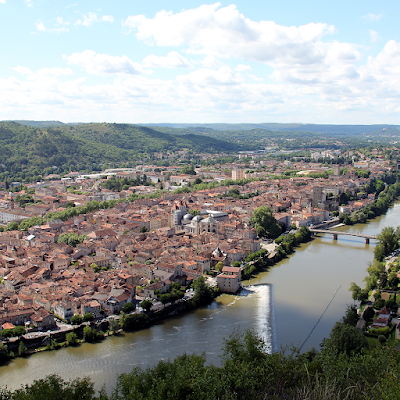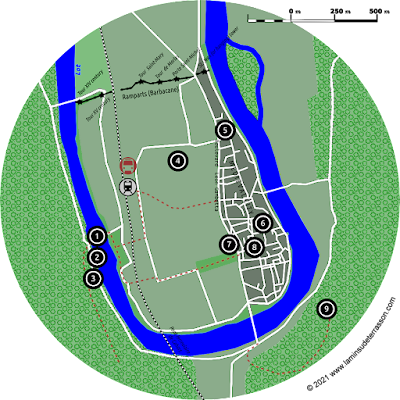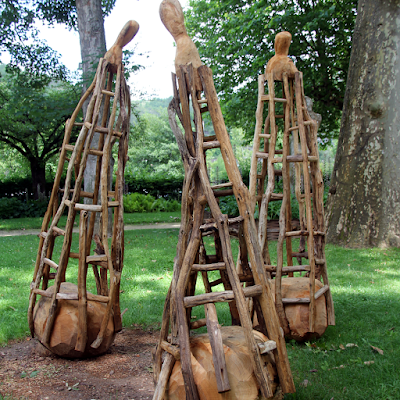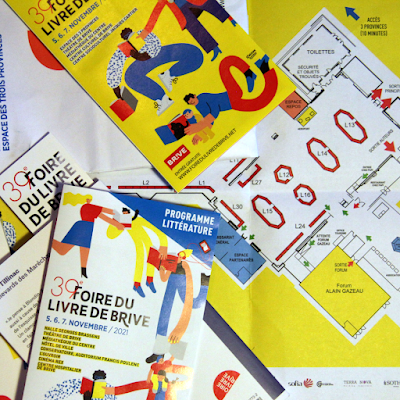 |
| Views of Cahors from Le Mont Saint Cyr. |
 |
| One of the Secret Gardens of Cahors. |
 |
| Arriving at the train station of Cahors. |
 |
| The Valentré bridge; icon of Cahors. |
In 1879 a sculpture of the devil was added to the central tower as a reference to the legend. The statue is still there today.
 |
| Little sculpture of the devil. |
The birthplace of Cahors, the Fontaine des Chartreux (3)(a large natural well where an underground river comes to the surface), was a holy site dedicated to the Celtic goddess of water: Divona. Archaeological research brought to the surface roman coins dating back to the first centuries before and after Christ (yes, that strange habit of throwing coins into fountains goes way-back).
 |
| Fontaine des Chartreux; the birthplace of Cahors. |
 |
| Map of Cahors. |
This is the main attraction of Cahors, the old town can be found between the Boulevard Léon Gambetta on the west and the river Lot on the east. Its moat, wall and gates disappeared under the boulevard, but for the rest the original structure of small streets, alleys and courtyards has been well preserved. A program of restoration has been ongoing and some buildings stand out, but much remains a bit raw and to be discovered. La Halle de Cahors (8) dates back to 1865 and was recently renovated to meet modern standards is open Tuesday to Saturday 8:30AM–2PM, 3:30–7PM, Sunday morning (Monday’s closed) with a large selection of local produce on offer.
 |
|
La Halle de Cahors. |
 |
| One of the Saint-Etienne cathedral decorated dooms. |
 |
| The ramparts or Barbacane. |
The city of Cahors has a clear medieval old town still recognizable today. The wall, moat and gates that ones protected this part have been demolished to make space for the Boulevard Léon Gambetta. A second (or first line of) defense has however been largely preserved. These ramparts run from the river on west to the river on east of the peninsula, that way creating an island protected largely by the river, and the wall. The ramparts date back to the 7th century and were reconstructed and improved upon in the 12th and 14th. On the eastern side the Barbacane and the St.-Jean (or hanging) tower form an interesting cluster of buildings. Enclosed you will find the Closelet des Croisades garden with plants that were brought back from the middle east like the Rose of Damascus, Myrtle, Agapanthus and peach.
 |
|
The Secret Gardens of Cahors. |
Explore these 30 little gardens with their evocative names: The Garden of Inebriation, the Little Garden of the Poor Clares, the Garden of the Ladies of Cahors... etc. The Jardin de la Sorcière et du Dragon (the Garden of the Witch and the Dragon) is an enclosed garden with plants connected to sorcery and witchcraft. Get a free map from the tourism office.
 |
|
La Villa Cahors Malbec. |
Although there are plenty of restaurants, bars, terraces and shops where you can buy and sample Cahors wines around town. This visitor information and wine tasting center next to the tourist office invites the visitor to discover all about the wonderful wines of Cahors and their history. Run jointly by the Tourist Office and the Union of Cahors Wine Professionals it offers wine tasting and background information.




No comments:
Post a Comment